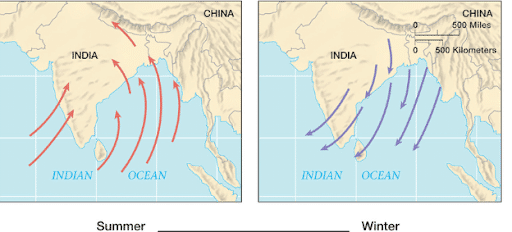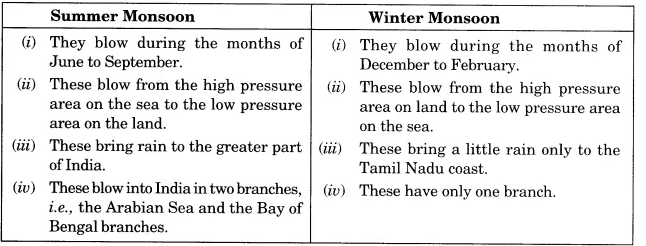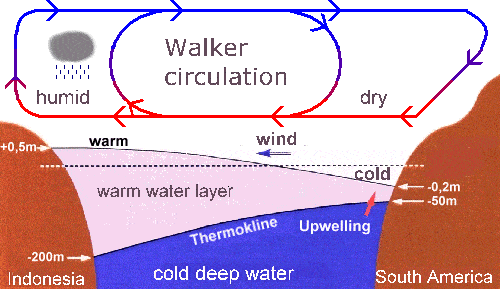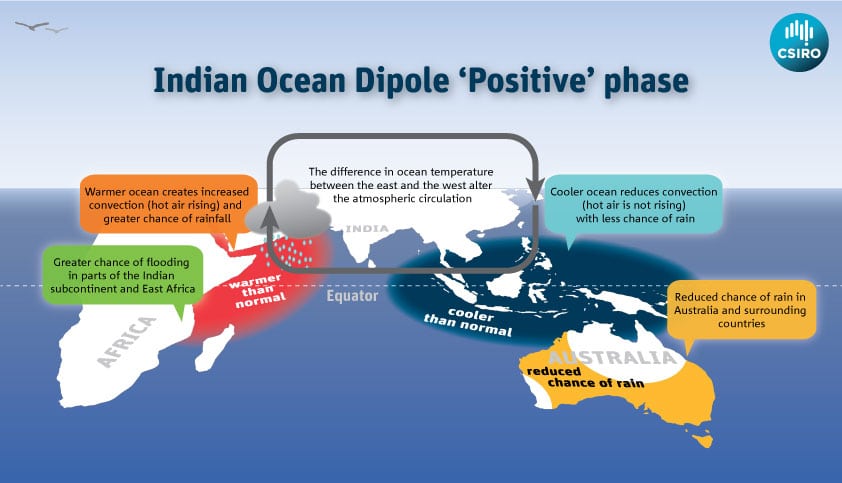Indian Monsoon
- The word ‘monsoon’ is believed to have originated from the Arabic word for season ‘mawsim’. Monsoons are basically seasonal winds that reverse their direction according to the change in season. They are hence, periodic winds.
- The monsoons travel from the sea to the land in summers and from land to the sea during winters, hence, are a double system of seasonal winds.
- Some scholars tend to treat the monsoon winds as land and sea breeze on a large scale.
- Historically the monsoons have been very important because these winds were used by traders and seafarers to move from place to place. Though there is monsoon in the Indian subcontinent, central-western Africa, Southeast Asia, and a few other places, the winds are most pronounced in the Indian subcontinent.
- India gets southwest monsoon winds in the summers and northeast monsoons during the winters. The former arise because of the formation of an intense low-pressure system over the Tibetan Plateau. The latter arises due to the high-pressure cells that are formed over the Siberian and Tibetan plateaus.
- South-west monsoons bring intense rainfall to most of the regions in India and north-east monsoons bring rainfall to mainly south-eastern coast of India (Southern coast of Seemandhra and the coast of Tamil Nadu.).
- Countries like India, Indonesia, Bangladesh, Myanmar etc. receive most of the annual rainfall during south-west monsoon season where as South East China, Japan etc., during north-east rainfall season.

 Mechanism of Indian Monsoon
Mechanism of Indian Monsoon
The monsoons are experienced in the tropical area roughly between 20° N and 20° S. Monsoon is a complex meteorological phenomenon. The origin of monsoons is not fully understood. There are several theories that tried to explain the mechanism of monsoons. To understand the mechanism of the monsoons, the following facts are important
Thermal Concept
- Halley, a noted astronomer, made a hypothesis that the primary cause of the Indian monsoon circulation was the differential heating effects of the land and the sea. According to this concept, monsoons are the extended land breeze and sea breeze on a large scale. During winter the huge landmass of Asia cools more rapidly than the surrounding oceans with the result that a strong high-pressure centre develops over the continent. On the other hand, the pressure over adjacent oceans is relatively lower. As a consequence the pressure- gradient is directed from land to sea. Therefore there is an outflow of air from the continental landmass towards the adjacent oceans so that it brings cold, dry air towards the low latitudes.
- In summer, the temperature and pressure conditions are reversed. Now, the huge landmass of Asia heats quickly and develops a strong low-pressure centre. Moreover, the poleward shift of the Intertropical Convergence Zone (ITCZ) to a position over Southern Asia reinforces the thermally induced low-pressure centre. The pressure over the adjacent oceans being high, a seato-land pressure gradient is established. The surface airflow is, therefore, from the highs over the oceans towards the lows over the heated land. The air that is attracted into the centers of low pressure from over the oceans is warm and moist.
- Halley’s concept is criticized on the following lines:
- It fails to explain the intricacies of monsoon such as the sudden burst of monsoon, breaks in monsoon, the spatial and temporal distribution of monsoon. The low-pressure areas are not stationary. The rainfall is not only convectional but a mix of orographic, cyclonic, and convectional rainfall.
Recent Concept about the Origin of Indian Monsoon
After world war second, the upper atmospheric circulation has been studied significantly. It is now believed that the differential heating of sea and land alone can’t produce monsoon circulation. Apart from it, the recent concept of monsoon rely heavily on the role of
- Himalayas and Tibetan plateau as a physical barrier and a source of high-level heat.
- Circulation of upper air jet streams in the troposphere.
- Existence of upper air circum-polar whirl over north and south poles in the troposphere.
- The occurrence of ENSO (El-Nino and Southern Oscillation) in the South Pacific ocean
- Walker cell in Indian Ocean.
- Indian Ocean Dipole
Role of the Himalayas and Tibetan Plateau
- In the 1970s, it was found that the Tibet plateau plays a crucial role in initiating the monsoon circulation. The plateau of Tibet extends over an area of about 4.5 million sq. km. The average height of these highlands is 4000 m. Due to its enormous height, it receives 2-3oC more insolation than the neighboring areas. The heating of these areas leads to clockwise air circulation in the middle troposphere and two-wind streams originate from this area. One of these wind streams blows southward and develops into the tropical easterly jet stream (TEJ). The other stream blows in an opposite direction towards the North Pole and becomes the westerly jet stream over Central Asia.

Role of Jet Stream
- As already discussed, the sub-tropical westerly jet stream is bifurcated by the high-land Tibet in winters. The northward branch extends up to 20N-35N. Tropical easterly jet stream (TEJ), that branch off from anticyclone developed over Tibet, sometimes reaches to the tip of Peninsular India. Apart from this, Jet speed winds are also reported over other parts of Peninsular. This jet descends over the Indian Ocean and intensifies its high-pressure cell known as Mascarene High. It is from this high-pressure cell that the onshore winds start blowing towards the thermally induced low-pressure area, developed in the northern part of the Indian subcontinent. After crossing the equator such winds become south-westerly and are known as the southwesterly summer monsoon.


Role of ENSO
- The Indian monsoon is also influenced by EL-Nino, southern oscillation, and Somalian current. We know that El Nino is the reversal of normal conditions in the Pacific Ocean’s sea surface temperature. Though there is no direct correlation between bad monsoon and El Nino, but both are generally associated. There are years when India faced severe drought and those are not El -Nino years and vice-versa. Southern Oscillation is the see-saw pattern of atmospheric pressure between the eastern and western Pacific oceans. The oscillation has a period varying from 2-7 years. It is measured with Southern Oscillation Index (SOI) by measuring the pressure difference between two points in the Pacific Ocean (Tahiti and Darwin). A negative value of SOI implies high pressure over the north Indian Ocean during the winter season and a poor monsoon.
- The Somalian current changes its direction of flow after every six months. During the North-East Monsoon, the Somali Current flows to the south-west, while during the South-West Monsoon it is a major western boundary current, comparable with the Gulf Stream. Normally, there remains a low-pressure area along the eastern coast of Somalia. In exceptional years, after every six or seven years, the low-pressure area in the western Arabian Sea becomes a high-pressure area. Such a pressure reversal results into a weaker monsoon in India.
Walker Cell
- It is observed that there is an east-west atmospheric circulation over the tropical oceanic regions. Such circulation in the Pacific Ocean is generally called walker cell. However, many scientists use the term ‘walker cell’ for all east-west circulations in different oceans. Walker cell is associated with southern oscillation and its strength fluctuates with that of the Southern Oscillation Index (SOI). With a high positive SOI, there would be a zone of low atmospheric pressure over Australia and the Indonesian archipelago. The rising air from this region deflects in the upper atmosphere in both directions towards Africa and South America. In the Indian Ocean, the air descends down at a high-pressure zone from where surface winds blow as Southwest monsoon towards the Indian sub-continent in summers. During La-Nina Indian ocean branch of the walker cell gets strengthened and surface winds are more intense. La-Nina condition is generally associated with good monsoon.

- During the appearance of El-Nino or negative SOI, the ascending branch of the Walker cell shifts to the central regions of the Pacific Ocean from the western pacific region (Figure 8). In a result, the Indian Ocean cell shifts towards the east. The surface winds or Southwest monsoon winds are weaker than normal conditions.

Indian Ocean Dipole
- The Indian Ocean Dipole (IOD) also known as the Indian Nino is a coupled Ocean-atmosphere phenomenon in the Indian Ocean. It is defined by the difference in sea surface temperature between two areas (or poles, hence a dipole) – a western pole in the Arabian Sea (western Indian Ocean) and an eastern pole in the eastern Indian Ocean south of Indonesia. The IOD Involves a periodic oscillation of sea-surface temperatures (SST), between “positive”, “neutral” and “negative” phases. A positive phase sees greater-than-average sea-surface temperatures and greater precipitation in the western Indian Ocean region, with a corresponding cooling of waters in the eastern Indian Ocean—which tends to cause droughts in adjacent land areas of Indonesia and Australia. The negative phase of the IOD brings about the opposite conditions, with warmer water and greater precipitation in the eastern Indian Ocean, and cooler and drier conditions in the west.
- The IOD is one aspect of the general cycle of global climate, interacting with similar phenomena like the El Niño-Southern Oscillation (ENSO) in the Pacific Ocean. Positive and negative IOD both have been seen coupled with La Nina. Thus, there is no direct correlation between IOD and ENSO.
- The IOD also affects the strength of monsoons over the Indian subcontinent. Positive IOD which is associated with warm sea-surface temperatures of the western Indian Ocean is favorable for monsoon.

Nature of Indian Monsoon
Systematic studies of the causes of rainfall in the South Asian region help to understand the salient features of the monsoon, particularly some of its important aspects, such as:
- Onset and advance of monsoon
- Rain-bearing systems and the relationship between their frequency and distribution of
- monsoon rainfall.
- Break in the monsoon
- Retreat of the monsoon

